Abstract
As a major cause of acute and chronic liver disease as well as hepatocellular carcinoma, hepatitis B virus (HBV) continues to pose significant health problems world-wide. Recombinant hepatitis B vaccines based on adenovirus vectors have been developed to address global needs for effective control of hepatitis B infection. Although considerable progress has been made in the construction of recombinant adenoviruses that express large amounts of HBV gene products, preclinical immunogenicity and efficacy testing of candidate vaccines has remained difficult due to the lack of a suitable animal model. We demonstrate here that chimpanzees are susceptible to enteric infection by human adenoviruses type 7 (Ad7) and type 4 (Ad4) following oral administration of live virus. Moreover, after sequential oral immunization with Ad7- and Ad4-vectored vaccines containing the hepatitis B surface antigen (HBsAg) gene, significant antibody responses to HBsAg (anti-HBs) were induced in two chimpanzees. After challenge with heterologous HBV, one chimpanzee was protected from acute hepatitis and the other chimpanzee experienced modified HBV-induced disease. These data demonstrate the feasibility of using orally administered recombinant adenoviruses as a general approach to vaccination.
Full text
PDF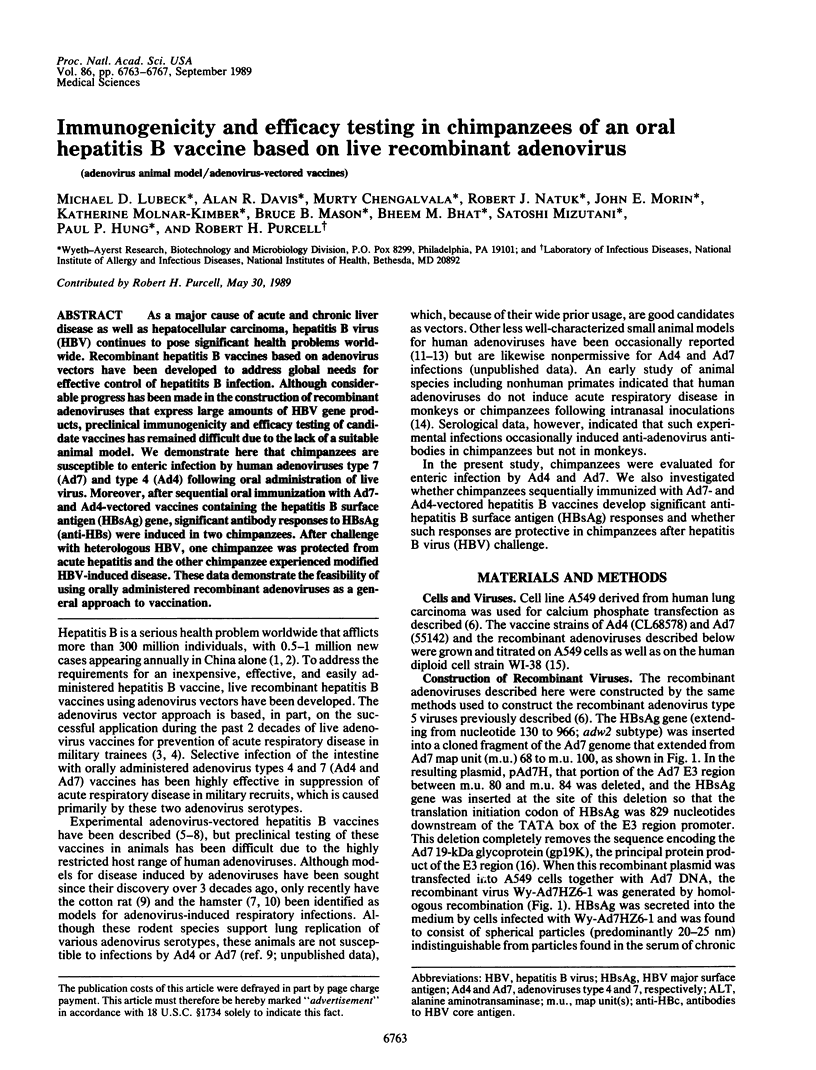
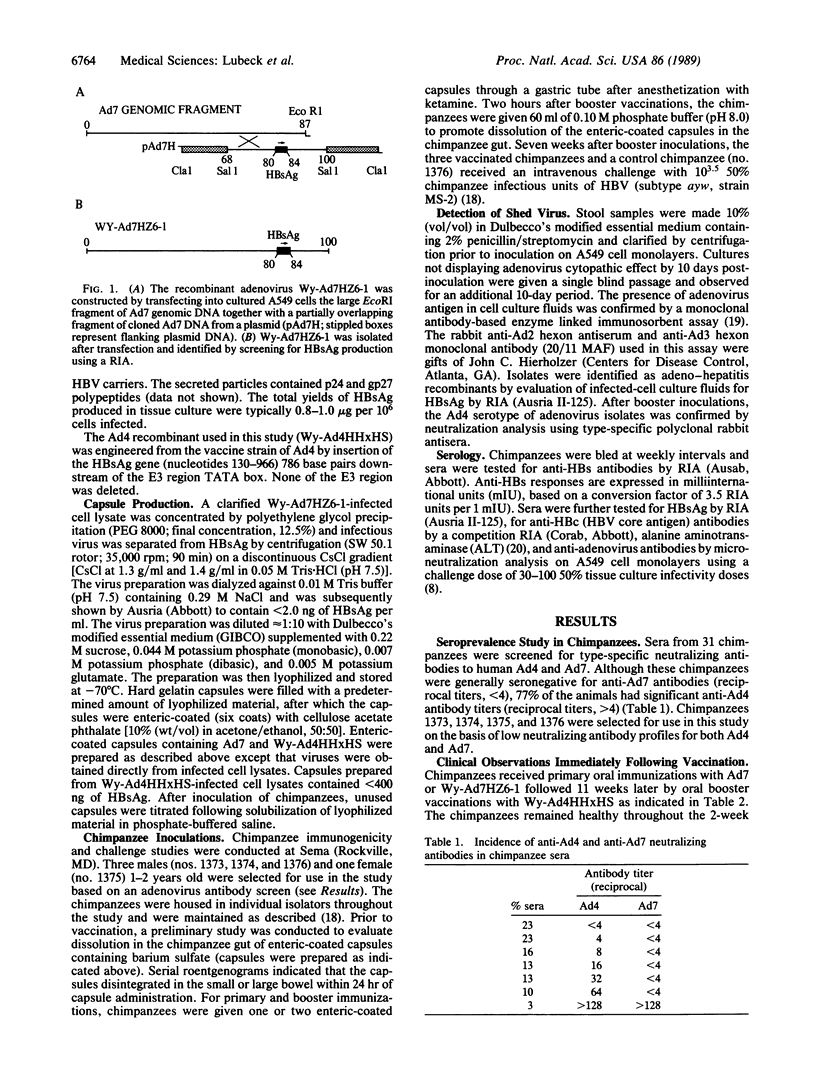
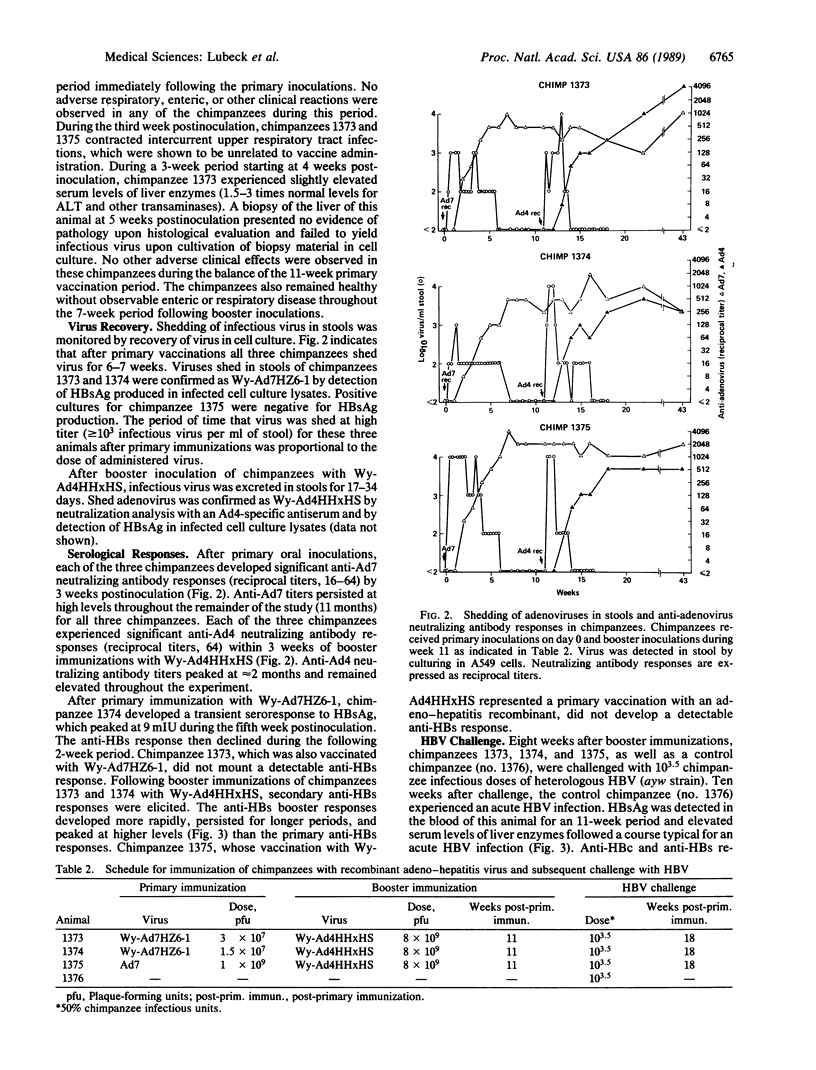
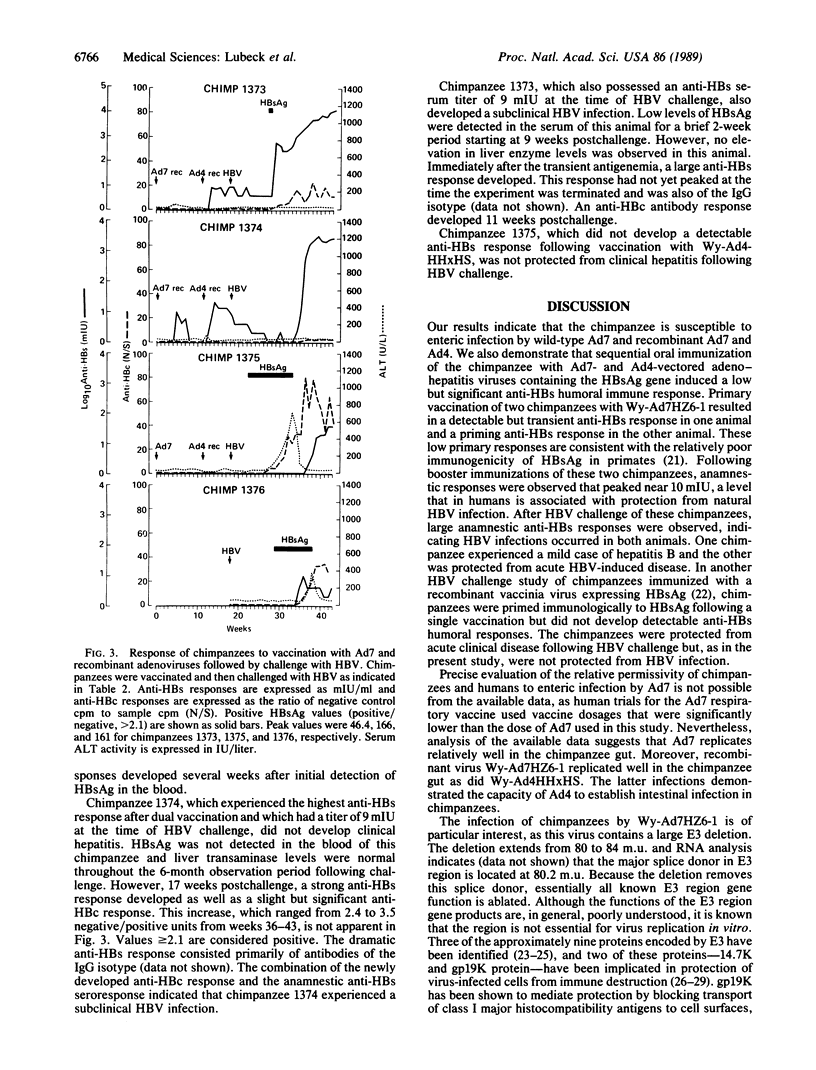
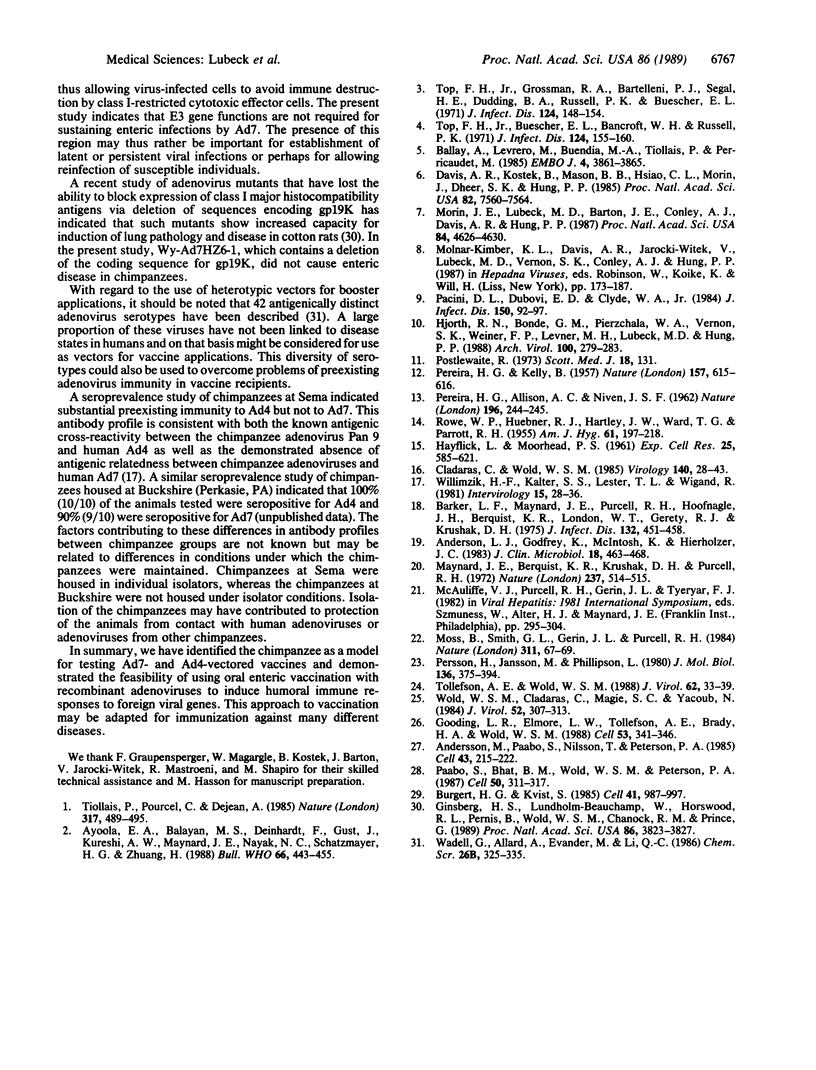
Selected References
These references are in PubMed. This may not be the complete list of references from this article.
- Anderson L. J., Godfrey E., McIntosh K., Hierholzer J. C. Comparison of a monoclonal antibody with a polyclonal serum in an enzyme-linked immunosorbent assay for detecting adenovirus. J Clin Microbiol. 1983 Sep;18(3):463–468. doi: 10.1128/jcm.18.3.463-468.1983. [DOI] [PMC free article] [PubMed] [Google Scholar]
- Andersson M., Päbo S., Nilsson T., Peterson P. A. Impaired intracellular transport of class I MHC antigens as a possible means for adenoviruses to evade immune surveillance. Cell. 1985 Nov;43(1):215–222. doi: 10.1016/0092-8674(85)90026-1. [DOI] [PubMed] [Google Scholar]
- Ballay A., Levrero M., Buendia M. A., Tiollais P., Perricaudet M. In vitro and in vivo synthesis of the hepatitis B virus surface antigen and of the receptor for polymerized human serum albumin from recombinant human adenoviruses. EMBO J. 1985 Dec 30;4(13B):3861–3865. doi: 10.1002/j.1460-2075.1985.tb04158.x. [DOI] [PMC free article] [PubMed] [Google Scholar]
- Barker L. F., Maynard J. E., Purcell R. H., Hoofnagle J. H., Berquist K. R., London W. T., Gerety R. J., Krushak D. H. Hepatitis B virus infection in chimpanzees: titration of subtypes. J Infect Dis. 1975 Oct;132(4):451–458. doi: 10.1093/infdis/132.4.451. [DOI] [PubMed] [Google Scholar]
- Burgert H. G., Kvist S. An adenovirus type 2 glycoprotein blocks cell surface expression of human histocompatibility class I antigens. Cell. 1985 Jul;41(3):987–997. doi: 10.1016/s0092-8674(85)80079-9. [DOI] [PubMed] [Google Scholar]
- Cladaras C., Wold W. S. DNA sequence of the early E3 transcription unit of adenovirus 5. Virology. 1985 Jan 15;140(1):28–43. doi: 10.1016/0042-6822(85)90443-x. [DOI] [PubMed] [Google Scholar]
- Davis A. R., Kostek B., Mason B. B., Hsiao C. L., Morin J., Dheer S. K., Hung P. P. Expression of hepatitis B surface antigen with a recombinant adenovirus. Proc Natl Acad Sci U S A. 1985 Nov;82(22):7560–7564. doi: 10.1073/pnas.82.22.7560. [DOI] [PMC free article] [PubMed] [Google Scholar]
- Ginsberg H. S., Lundholm-Beauchamp U., Horswood R. L., Pernis B., Wold W. S., Chanock R. M., Prince G. A. Role of early region 3 (E3) in pathogenesis of adenovirus disease. Proc Natl Acad Sci U S A. 1989 May;86(10):3823–3827. doi: 10.1073/pnas.86.10.3823. [DOI] [PMC free article] [PubMed] [Google Scholar]
- Gooding L. R., Elmore L. W., Tollefson A. E., Brady H. A., Wold W. S. A 14,700 MW protein from the E3 region of adenovirus inhibits cytolysis by tumor necrosis factor. Cell. 1988 May 6;53(3):341–346. doi: 10.1016/0092-8674(88)90154-7. [DOI] [PubMed] [Google Scholar]
- Hjorth R. N., Bonde G. M., Pierzchala W. A., Vernon S. K., Wiener F. P., Levner M. H., Lubeck M. D., Hung P. P. A new hamster model for adenoviral vaccination. Arch Virol. 1988;100(3-4):279–283. doi: 10.1007/BF01487691. [DOI] [PubMed] [Google Scholar]
- Maynard J. E., Berquist K. R., Krushak D. H., Purcell R. H. Experimental infection of chimpanzees with the virus of hepatitis B. Nature. 1972 Jun 30;237(5357):514–515. doi: 10.1038/237514a0. [DOI] [PubMed] [Google Scholar]
- Morin J. E., Lubeck M. D., Barton J. E., Conley A. J., Davis A. R., Hung P. P. Recombinant adenovirus induces antibody response to hepatitis B virus surface antigen in hamsters. Proc Natl Acad Sci U S A. 1987 Jul;84(13):4626–4630. doi: 10.1073/pnas.84.13.4626. [DOI] [PMC free article] [PubMed] [Google Scholar]
- Moss B., Smith G. L., Gerin J. L., Purcell R. H. Live recombinant vaccinia virus protects chimpanzees against hepatitis B. Nature. 1984 Sep 6;311(5981):67–69. doi: 10.1038/311067a0. [DOI] [PubMed] [Google Scholar]
- PEREIRA H. G., KELLY B. Latent infection of rabbits by adenovirus type 5. Nature. 1957 Sep 21;180(4586):615–616. doi: 10.1038/180615b0. [DOI] [PubMed] [Google Scholar]
- Pacini D. L., Dubovi E. J., Clyde W. A., Jr A new animal model for human respiratory tract disease due to adenovirus. J Infect Dis. 1984 Jul;150(1):92–97. doi: 10.1093/infdis/150.1.92. [DOI] [PubMed] [Google Scholar]
- Persson H., Jansson M., Philipson L. Synthesis and genomic site for an adenovirus type 2 early glycoprotein. J Mol Biol. 1980 Feb 5;136(4):375–394. doi: 10.1016/0022-2836(80)90396-4. [DOI] [PubMed] [Google Scholar]
- Progress in the control of viral hepatitis: memorandum from a WHO meeting. Bull World Health Organ. 1988;66(4):443–455. [PMC free article] [PubMed] [Google Scholar]
- Päbo S., Bhat B. M., Wold W. S., Peterson P. A. A short sequence in the COOH-terminus makes an adenovirus membrane glycoprotein a resident of the endoplasmic reticulum. Cell. 1987 Jul 17;50(2):311–317. doi: 10.1016/0092-8674(87)90226-1. [DOI] [PMC free article] [PubMed] [Google Scholar]
- Tiollais P., Pourcel C., Dejean A. The hepatitis B virus. Nature. 1985 Oct 10;317(6037):489–495. doi: 10.1038/317489a0. [DOI] [PubMed] [Google Scholar]
- Tollefson A. E., Wold W. S. Identification and gene mapping of a 14,700-molecular-weight protein encoded by region E3 of group C adenoviruses. J Virol. 1988 Jan;62(1):33–39. doi: 10.1128/jvi.62.1.33-39.1988. [DOI] [PMC free article] [PubMed] [Google Scholar]
- Top F. H., Jr, Buescher E. L., Bancroft W. H., Russell P. K. Immunization with live types 7 and 4 adenovirus vaccines. II. Antibody response and protective effect against acute respiratory disease due to adenovirus type 7. J Infect Dis. 1971 Aug;124(2):155–160. doi: 10.1093/infdis/124.2.155. [DOI] [PubMed] [Google Scholar]
- Top F. H., Jr, Grossman R. A., Bartelloni P. J., Segal H. E., Dudding B. A., Russell P. K., Buescher E. L. Immunization with live types 7 and 4 adenovirus vaccines. I. Safety, infectivity, antigenicity, and potency of adenovirus type 7 vaccine in humans. J Infect Dis. 1971 Aug;124(2):148–154. doi: 10.1093/infdis/124.2.148. [DOI] [PubMed] [Google Scholar]
- Willimzik H. F., Kalter S. S., Lester T. L., Wigand R. Immunological relationship among adenoviruses of humans, simians, and nonprimates as determined by the neutralization test. Intervirology. 1981;15(1):28–36. doi: 10.1159/000149211. [DOI] [PubMed] [Google Scholar]
- Wold W. S., Cladaras C., Magie S. C., Yacoub N. Mapping a new gene that encodes an 11,600-molecular-weight protein in the E3 transcription unit of adenovirus 2. J Virol. 1984 Nov;52(2):307–313. doi: 10.1128/jvi.52.2.307-313.1984. [DOI] [PMC free article] [PubMed] [Google Scholar]


